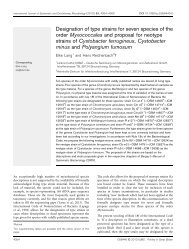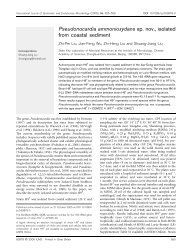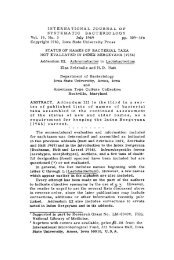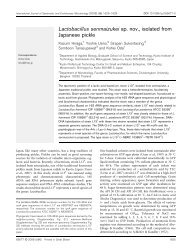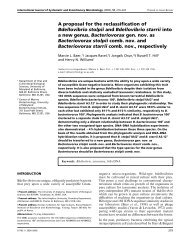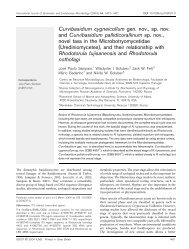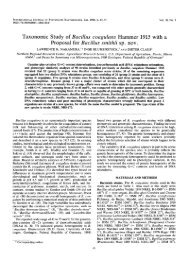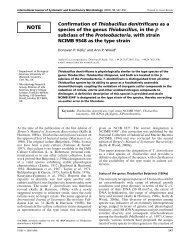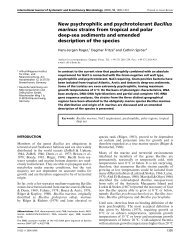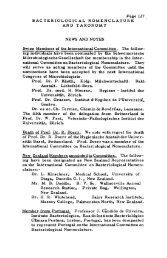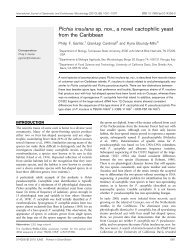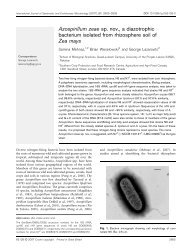Methanocella paludicola gen. nov., sp. nov., a methane-producing ...
Methanocella paludicola gen. nov., sp. nov., a methane-producing ...
Methanocella paludicola gen. nov., sp. nov., a methane-producing ...
Create successful ePaper yourself
Turn your PDF publications into a flip-book with our unique Google optimized e-Paper software.
International Journal of Systematic and Evolutionary Microbiology (2008), 58, 929–936 DOI 10.1099/ijs.0.65571-0<br />
Corre<strong>sp</strong>ondence<br />
Hiroyuki Imachi<br />
imachi@jamstec.go.jp<br />
Rice paddy fields are one of the major sources of the<br />
greenhouse gas <strong>methane</strong>, contributing about 10–25 % of<br />
global <strong>methane</strong> emission (Dentener et al., 2001; Neue,<br />
Abbreviation: RC-I, Rice Cluster I.<br />
The GenBank/EMBL/DDBJ accession numbers for the 16S rRNA <strong>gen</strong>e<br />
and mcrA <strong>gen</strong>e sequences of strain SANAE T are AB196288 and<br />
AB300467, re<strong>sp</strong>ectively.<br />
<strong>Methanocella</strong> <strong>paludicola</strong> <strong>gen</strong>. <strong>nov</strong>., <strong>sp</strong>. <strong>nov</strong>., a<br />
<strong>methane</strong>-<strong>producing</strong> archaeon, the first isolate of the<br />
lineage ‘Rice Cluster I’, and proposal of the new<br />
archaeal order <strong>Methanocella</strong>les ord. <strong>nov</strong>.<br />
Sanae Sakai, 1 Hiroyuki Imachi, 1,2 Satoshi Hanada, 3 Akiyoshi Ohashi, 1,4<br />
Hideki Harada 1,5 and Yoichi Kamagata 1,3,6<br />
1<br />
Department of Environmental Systems Engineering, Nagaoka University of Technology, Nagaoka,<br />
Niigata 940-2188, Japan<br />
2 Subground Animalcule Retrieval (SUGAR) Program, Extremobio<strong>sp</strong>here Research Center, Japan<br />
A<strong>gen</strong>cy for Marine-Earth Science and Technology (JAMSTEC), Yokosuka, Kanagawa 237-0061,<br />
Japan<br />
3 Institute for Biological Resources and Functions, National Institute of Advanced Industrial Science<br />
and Technology (AIST), Tsukuba, Ibaraki 305-8566, Japan<br />
4<br />
Department of Social and Environmental Engineering, Hiroshima University, Hiroshima 739-8527,<br />
Japan<br />
5 Department of Civil and Environmental Engineering, Tohoku University, Sendai 980-8579, Japan<br />
6 Research Institute of Genome-Based Biofactory, National Institute of Advanced Industrial Science<br />
and Technology (AIST), Sapporo, Hokkaido 062-8517, Japan<br />
A <strong>nov</strong>el mesophilic, hydro<strong>gen</strong>otrophic methano<strong>gen</strong>, strain SANAE T , was isolated from an<br />
anaerobic, propionate-degrading enrichment culture, which was originally established from rice<br />
paddy soil. The cells were non-motile, Gram-negative and rod-shaped (1.8–2.4 mm long by 0.3–<br />
0.6 mm wide). Growth of strain SANAE T was observed at 25–40 6C, with an optimum<br />
temperature range for growth of 35–37 6C. The pH range for growth was 6.5–7.8, with an<br />
optimum at pH 7.0. The salinity range for growth was 0–1 g NaCl l ”1 (0–17 mM). The isolate was<br />
able to utilize H2/CO2 and formate for growth and <strong>methane</strong> production. The G+C content of the<br />
<strong>gen</strong>omic DNA was 56.6 mol%. Based on comparative 16S rRNA <strong>gen</strong>e sequence analysis, strain<br />
SANAE T was affiliated with a clone lineage of the Archaea, Rice Cluster I (RC-I), placing it<br />
between the orders Methanosarcinales and Methanomicrobiales within the class<br />
‘Methanomicrobia’. 16S rRNA <strong>gen</strong>e sequence similarities between strain SANAE T and members<br />
of Methanosarcinales were in the range 80.0–82.8 %, and those between the strain and members<br />
of Methanomicrobiales ranged from 77.5 to 82.4 %. In addition to 16S rRNA <strong>gen</strong>e analysis,<br />
sequence analysis of the mcrA <strong>gen</strong>e (encoding the a subunit of methyl-coenzyme M reductase, a<br />
key enzyme in the <strong>methane</strong> production pathway) also showed that strain SANAE T was affiliated<br />
with the RC-I lineage. Here, we propose the name <strong>Methanocella</strong> <strong>paludicola</strong> <strong>gen</strong>. <strong>nov</strong>., <strong>sp</strong>. <strong>nov</strong>. for<br />
the isolate, the first of the RC-I lineage. The type strain is SANAE T (5JCM 13418 T 5NBRC<br />
101707 T 5DSM 17711 T ). In addition, we also propose the status of order for the RC-I lineage, for<br />
which we propose the name <strong>Methanocella</strong>les ord. <strong>nov</strong>.<br />
1993). Methane emission from rice paddy fields is attributed<br />
to methano<strong>gen</strong>ic Archaea (methano<strong>gen</strong>s), the key<br />
organisms re<strong>sp</strong>onsible for the final step of the anoxic<br />
degradation of organic substances. The Rice Cluster I<br />
(RC-I) lineage, which hitherto has been comprised solely<br />
of 16S rRNA <strong>gen</strong>e clone sequences, plays a key role in<br />
<strong>methane</strong> production in rice paddy fields (Lu & Conrad,<br />
2005; Conrad et al., 2006). De<strong>sp</strong>ite their numerical<br />
65571 G 2008 IUMS Printed in Great Britain 929
S. Sakai and others<br />
significance and cosmopolitan di<strong>sp</strong>ersal, RC-I methano<strong>gen</strong>s<br />
have so far escaped isolation.<br />
Recently, we have successfully isolated a <strong>nov</strong>el methano<strong>gen</strong>ic<br />
archaeon, designated strain SANAE T , belonging to<br />
the RC-I lineage from a Japanese rice paddy field. Enrichment<br />
and isolation of strain SANAE T was achieved by<br />
application of the co-culture approach with Syntrophobacter<br />
fumaroxidans as the hydro<strong>gen</strong>-<strong>producing</strong> syntrophic<br />
partner (Sakai et al., 2007). In a previous publication we<br />
described the isolation of strain SANAE T . Here we give a<br />
detailed description of strain SANAE T , including morphological,<br />
physiological and <strong>gen</strong>etic properties. We propose<br />
that strain SANAE T is the type strain of a <strong>nov</strong>el <strong>sp</strong>ecies<br />
within a <strong>nov</strong>el <strong>gen</strong>us with the name <strong>Methanocella</strong><br />
<strong>paludicola</strong> <strong>gen</strong>. <strong>nov</strong>., <strong>sp</strong>. <strong>nov</strong>. In addition, we propose the<br />
order <strong>Methanocella</strong>les ord. <strong>nov</strong>., with the newly isolated<br />
methano<strong>gen</strong> as a representative of the new order.<br />
The basal medium used in this study was prepared as<br />
described previously (Sekiguchi et al., 2000). All cultivations<br />
were performed at 37 uC in 50 ml serum vials<br />
containing 20 ml medium (pH at 25 uC, 7.0) under an<br />
atmo<strong>sp</strong>here of N2/CO2 (80/20, v/v) without shaking, unless<br />
otherwise mentioned. Growth and substrate utilization was<br />
determined by monitoring the optical density of the<br />
cultures (at 600 nm) and the concentration of <strong>methane</strong>.<br />
Incubations were stopped after 3 months. The pH, temperature<br />
and salinity range of strain SANAE T were determined<br />
in standard media containing 0.01 % yeast extract<br />
and 1 mM acetate. The gas phase contained H2 at<br />
approximately 150 kPa. Temperature tests were carried<br />
out between 18 and 60 uC, pH tests between pH 5.5 and<br />
8.0, and salinity tests between 1 and 30 g NaCl l 21 (17–<br />
513 mM). During the pH test, the medium was routinely<br />
monitored to observe if the initial pH conditions were<br />
changed or not. Salinity tests were performed using the<br />
same medium described above (which already contains<br />
33 mM Na + and 14 mM Cl 2 ). Antibiotics were evaluated<br />
with cultures supplemented at final concentrations of<br />
100 mg antibiotic ml 21 . Antibiotic susceptibility tests were<br />
carried out at 37 uC for a period of 2 months. All measurements<br />
were performed in triplicate.<br />
Cell morphology and motility were examined by a phasecontrast<br />
microscope (Olympus model BX50F). Gram<br />
staining was carried out according to the method of<br />
Hucker (Doetsch, 1981). The susceptibility of the isolate to<br />
deter<strong>gen</strong>ts was tested with SDS at concentrations ranging<br />
from 0.01 to 2.5 %, and cell lysis was determined by<br />
microscopic observation of cell integrity. Transmission<br />
electron microscopy was performed as described previously<br />
(Sekiguchi et al., 2003). Short-chain fatty acids, alcohols,<br />
<strong>methane</strong>, H2 and carbon dioxide were measured as<br />
described previously (Imachi et al., 2000, 2002, 2006).<br />
The G+C content of the <strong>gen</strong>omic DNA was determined by<br />
the method of Kamagata & Mikami (1991).<br />
All procedures for DNA extraction, PCR amplification and<br />
sequencing have been reported previously (Imachi et al.,<br />
2006). PCR was carried out using primer pairs Arch21F<br />
(DeLong, 1992) and 1490R (Weisburg et al., 1991), and<br />
ME1 and ME2 (Hales et al., 1996), for amplification of<br />
the 16S rRNA and mcrA <strong>gen</strong>es, re<strong>sp</strong>ectively. Phylo<strong>gen</strong>etic<br />
analyses were performed using the ARB program (Ludwig<br />
et al., 2004). A 16S rRNA <strong>gen</strong>e-based tree was constructed<br />
by using the neighbour-joining method (Saitou & Nei,<br />
1987) for sequences having .1000 nt. Subsequently, shorter<br />
sequences were inserted into the tree without changing the<br />
tree topology by using the parsimony insertion tool of the<br />
ARB program. 16S rRNA <strong>gen</strong>e sequence similarity values<br />
were calculated using the Calculate Matrix function of the<br />
ARB program with Jukes and Cantor correction (Jukes &<br />
Cantor, 1969; Ludwig et al., 2004). A deduced McrA amino<br />
acid sequence-based phylo<strong>gen</strong>etic tree was constructed by<br />
the neighbour-joining method implemented in the ARB<br />
program with 265 amino acid positions and the percentage<br />
acceptance mutations (PAM) distance correction. For both<br />
phylo<strong>gen</strong>etic trees, the tree topologies were evaluated by<br />
using bootstrap resampling analysis (Felsenstein, 1985) for<br />
1000 replicates with the neighbour-joining, maximumparsimony<br />
and maximum-likelihood methods as described<br />
previously (Sekiguchi et al., 2006). Fluorescence in situ<br />
hybridization was performed as described by Sekiguchi<br />
et al. (1998). To detect strain SANAE T cells, a 16S rRNAtargeted<br />
oligonucleotide probe <strong>sp</strong>ecific for strain SANAE T ,<br />
SANAE1136 (Sakai et al., 2007), was used.<br />
Cells of strain SANAE T were non-motile, rod-shaped, 1.8–<br />
2.4 mm long and 0.3–0.6 mm wide, and occurred singly<br />
(Fig. 1). Coccoid cells were observed in a late-exponential<br />
phase culture with H2 or formate (Fig. 2). Fluorescence<br />
in situ hybridization probe targeting of SANAE T cells<br />
demonstrated that both cell types belong to strain<br />
SANAE T (Fig. 2). Cells of strain SANAE T autofluoresced<br />
in epifluorescence microscopy, indicating the presence of<br />
the methano<strong>gen</strong>-<strong>sp</strong>ecific coenzyme F420. The cells stained<br />
Fig. 1. Transmission electron micrograph of strain SANAE T . Bar,<br />
1 mm.<br />
930 International Journal of Systematic and Evolutionary Microbiology 58
Fig. 2. Photomicrographs of rod and coccoid cells of strain<br />
SANAE T . Phase-contrast (a) and fluorescence (b) micrographs of<br />
the cells in the same field of view, stained with a Cy-3-labelled 16S<br />
rRNA probe, SANAE1136. Arrows indicate coccoid cells. Bars,<br />
10 mm.<br />
Gram-negative and resisted disruption by less than 2 %<br />
(w/v) SDS. Colonies of strain SANAE T in a deep agar<br />
medium were white to cream, reaching a diameter of 1–<br />
1.5 mm after 6 months incubation with H2 as a substrate.<br />
Strain SANAE T required acetate as carbon source. Yeast<br />
extract supported growth; however, it was not required. H2 and formate (40 mM) supported growth and <strong>methane</strong><br />
production. The following substrates did not support<br />
growth and/or <strong>methane</strong> production: pyruvate (20 mM),<br />
lactate (20 mM), acetate (20 mM), 1-propanol (5 mM),<br />
2-propanol (5 mM), ethanol (5 mM), 1-butanol (5 mM),<br />
2-butanol (5 mM), cyclopentanol (5 mM), methanol<br />
(20 mM), methylamine (10 mM), trimethylamine (10 mM),<br />
dimethylamine (10 mM) and propionate (20 mM).<br />
Strain SANAE T grew between 25 and 40 uC with an<br />
optimum at 35–37 uC. The pH range for growth was<br />
between 6.5–7.8, with an optimum at around pH 7.0.<br />
The strain could grow at NaCl concentrations ranging<br />
from 0–1 g NaCl l 21 (0–17 mM). In medium containing<br />
2–4 g NaCl l 21 (34–68 mM), a small amount of <strong>methane</strong><br />
was detected; however, growth was inhibited because<br />
<strong>methane</strong> production was not increased. Methane production<br />
and growth were completely inhibited by 5 g NaCl l 21<br />
(86 mM). Under optimal conditions (pH 7.0, 37 uC), the<br />
doubling time, calculated from <strong>methane</strong> production rates,<br />
was 4.2 days. The strain tolerated ampicillin, penicillin G,<br />
vancomycin, kanamycin, bacitracin and streptomycin.<br />
Growth was inhibited by rifampicin, tetracycline and<br />
chloramphenicol.<br />
The DNA G+C content of strain SANAE T was 56.6 mol%.<br />
Analysis of its 16S rRNA <strong>gen</strong>e sequence affiliates strain<br />
SANAE T with sequences in the RC-I lineage (previously<br />
published in Sakai et al., 2007). Hitherto, this lineage,<br />
which falls between the orders Methanosarcinales and<br />
<strong>Methanocella</strong> <strong>paludicola</strong> <strong>gen</strong>. <strong>nov</strong>., <strong>sp</strong>. <strong>nov</strong>.<br />
Methanomicrobiales (Fig. 3), was exclusively composed of<br />
sequences retrieved from clone libraries. The 16S rRNA<br />
<strong>gen</strong>e sequence similarities between strain SANAE T and<br />
members of Methanosarcinales were in the range 80.0–<br />
82.8 %, and those between the strain and members of<br />
Methanomicrobiales ranged from 77.5 to 82.4 %. The closest<br />
cultured relative of strain SANAE T was Methanomethylovorans<br />
hollandica (82.8 % similarity). In addition to the<br />
16S rRNA <strong>gen</strong>e-based analysis, we also determined the<br />
partial sequence of the mcrA <strong>gen</strong>e in strain SANAE T<br />
(681 bp) and constructed a phylo<strong>gen</strong>etic tree based on the<br />
deduced amino acid sequence of mcrA <strong>gen</strong>es (Fig. 4). In<br />
this tree also, strain SANAE T affiliates with a member<br />
of the RC-I lineage. The closest relative based on McrA<br />
amino acid sequence was Methanosalsum zhilinae (71.8 %<br />
similarity).<br />
Phenotypic and <strong>gen</strong>etic analyses in this study showed that<br />
strain SANAE T is an H2-utilizing methano<strong>gen</strong> and that it<br />
should be considered to be a member of the RC-I lineage.<br />
Previous culture-dependent and -independent investigations<br />
have provided evidence that members of the RC-I<br />
lineage utilize H2 (Lueders et al., 2001; Sizova et al., 2003;<br />
Erkel et al., 2005, 2006; Lehmann-Richter et al., 1999). Erkel<br />
et al. (2006) constructed a complete <strong>gen</strong>ome sequence of<br />
an RC-I methano<strong>gen</strong> from an enrichment culture growing<br />
on H2 and revealed that the RC-I methano<strong>gen</strong> had a full set<br />
of <strong>gen</strong>es involved in methano<strong>gen</strong>esis from H2/CO2. Abundant populations of RC-I Archaea were detected in<br />
an acidophilic methano<strong>gen</strong>ic consortium supplemented<br />
with H2 as sole energy source (Sizova et al., 2003). The 16S<br />
rRNA <strong>gen</strong>e sequences from those RC-I enrichments were<br />
determined and are available from the Genbank/EMBL/<br />
DDBJ databases as AM114193 for the meta<strong>gen</strong>ome (the<br />
<strong>gen</strong>ome contained three rrn operons) and AF524853 for<br />
the acidophilic consortium. The sequence similarities<br />
between these RC-I enrichments and strain SANAE T were<br />
in the range 92.2–94.2 %, indicating that strain SANAE T<br />
and these RC-I organisms are phylo<strong>gen</strong>etically distinct<br />
from each other, at least at the <strong>sp</strong>ecies or <strong>gen</strong>us level.<br />
Since the discovery of RC-I, it has been recognized as a<br />
different <strong>gen</strong>otypic group from the orders Methanosarcinales<br />
and Methanomicrobiales because of the low sequence<br />
similarity values with those of the two aforementioned<br />
orders (Großkopf et al., 1998). In fact, as described above,<br />
the 16S rRNA <strong>gen</strong>e sequence similarities between strain<br />
SANAE T and members of the Methanosarcinales and<br />
Methanomicrobiales were also low. Additionally, the bootstrap<br />
values of both 16S rRNA <strong>gen</strong>e-based and McrA amino<br />
acid sequence-based phylo<strong>gen</strong>etic trees solidly supported<br />
the three lineages, Methanosarcinales, Methanomicrobiales<br />
and RC-I (Figs 3 and 4). These results suggest that RC-I,<br />
containing strain SANAE T , is certainly a monophyletic<br />
taxon at order level within the class ‘Methanomicrobia’<br />
(Garrity et al., 2003). Additionally, the physiological properties<br />
of strain SANAE T distinguish it clearly from<br />
members of the order Methanosarcinales, which utilize<br />
acetate and simple methylated compounds in contrast to<br />
http://ijs.sgmjournals.org 931
S. Sakai and others<br />
Fig. 3. Phylo<strong>gen</strong>etic tree of the class ‘Methanomicrobia’ based on comparative analyses of 16S rRNA <strong>gen</strong>e sequences,<br />
showing the placement of strain SANAE T . The tree was calculated based on a distance matrix analysis of 16S rRNA <strong>gen</strong>e<br />
sequences (neighbour-joining tree). The 16S rRNA <strong>gen</strong>e sequence of Methanobacterium formicicum (AY196659) was used as<br />
the outgroup. The sequences of Methanothrix (‘Methanosaeta’) thermophila and RC-I MRE50 were inferred from their complete<br />
<strong>gen</strong>omic sequences, and the position of each sequence is indicated after their accession number in parentheses. Bootstrap<br />
support (.50 % indicated only) was obtained from neighbour-joining (first value), maximum-parsimony (second value) and<br />
maximum-likelihood methods (third value) based on 1000 replicates. The accession number of each reference sequence is<br />
shown after each strain or clone name. The bar represents the number of changes per sequence position.<br />
Fig. 4. Phylo<strong>gen</strong>etic tree based on deduced McrA amino acid sequences, indicating the relationship between strain SANAE T<br />
and related methano<strong>gen</strong>ic Archaea. The tree was constructed based on a distance matrix (265 amino acid positions; PAM<br />
distance correction) by using the neighbour-joining method. The sequence of Methanopyrus kandleri (AE009439) was used as<br />
the outgroup. Bootstrap support was obtained from neighbour-joining (first value), maximum-parsimony (second value) and<br />
maximum-likelihood (third value) methods based on 1000 replicates. The accession number of each reference sequence is<br />
shown after each strain or clone name. The bar represents 10 % estimated sequence diver<strong>gen</strong>ce.<br />
932 International Journal of Systematic and Evolutionary Microbiology 58
http://ijs.sgmjournals.org 933<br />
Table 1. Comparison of morphological and physiological characteristics of strain SANAE T , and the families and a <strong>gen</strong>us within the orders Methanomicrobiales and<br />
Methanosarcinales<br />
Data for strain SANAE T is from this study. Data for other taxa were taken from the following studies: Methanomicrobiaceae (Boone et al., 1993, 2001a; Chong et al., 2002; Dianou et al., 2001;<br />
Mikucki et al., 2003; Lai & Chen, 2001; Wu et al., 2005); Methano<strong>sp</strong>irillaceae (Boone et al., 2001a); Methanocorpusculaceae (Boone et al., 1993, 2001a); Methanocalculus (Boone et al., 2001a; Lai et<br />
al., 2002, 2004; Mori et al., 2000); Methanosaetaceae (Boone et al., 2001b; Ma et al., 2006); Methanosarcinaceae (Boone et al., 1993, 2001b; Jiang et al., 2005; Lomans et al., 1999; Lyimo et al., 2000;<br />
Simankova et al., 2001; Singh et al., 2005; Sprenger et al., 2000; von Klein et al., 2002). Abbreviations, 2, Negative; +, positive; ; ±, dependent on the <strong>sp</strong>ecies; ND, not determined.<br />
Characteristic SANAE T<br />
Cell morphology Rod,<br />
coccus*<br />
Methanomicrobiales Methanosarcinales<br />
Methanomicrobiaceae Methano<strong>sp</strong>irillaceae Methanocorpusculaceae Genus<br />
Methanocalculus<br />
Curved or irregular rod,<br />
irregular coccus, or<br />
irregular plate or disk<br />
Methanosaetaceae Methanosarcinaceae<br />
Curved rod Coccus or irregular coccus Irregular coccus Rod Coccus, irregular<br />
coccus, or flat<br />
polygons<br />
Gram reaction 2 2 2 2 2 ± ±<br />
DNA G+C content<br />
(mol%)<br />
56.6 38.7–62.2 45 48.5–52 50.8–55 49.0–55.7 36.3–55<br />
Motility 2 ± + (weakly) ± 2 2 ±<br />
Optimum growth<br />
temperature (uC)<br />
35–37 20–55 30–37 30–37 35–38 34–55 20–50<br />
Optimum pH<br />
Substrate utilization<br />
7 6.0–7.9 6.6–7.4 6.5–7.0 6.5–7.6 6.7–7.6 6.0–9.5<br />
H2/CO2 + + + + + 2 ±<br />
Formate + + + + + 2 2<br />
Acetate 2 2 2 2 2 + ±<br />
Secondary alcohols 2 ± 2 ± 2 2 2<br />
Methanol or methylamines<br />
Growth requirements<br />
2 2 2 2 2 2 +<br />
Yeast extract 2 ± 2 ± 2 ± ±<br />
Acetate + ± 2 ± + ND ND<br />
*Cocci are observed in the late-exponential culture.<br />
<strong>Methanocella</strong> <strong>paludicola</strong> <strong>gen</strong>. <strong>nov</strong>., <strong>sp</strong>. <strong>nov</strong>.
S. Sakai and others<br />
strain SANAE T . However, the phenotypic distinction<br />
between strain SANAE T and members of the Methanomicrobiales<br />
is not so straightforward as both consume<br />
hydro<strong>gen</strong> and formate exclusively and have similar re<strong>sp</strong>onses<br />
to pH, temperature and salinity. They differ,<br />
however, in cell shape (Table 1).<br />
Based on these phenotypic and phylo<strong>gen</strong>etic data, we<br />
propose that strain SANAE T is the type strain of a <strong>nov</strong>el<br />
<strong>sp</strong>ecies within a <strong>nov</strong>el <strong>gen</strong>us, for which we propose the<br />
name <strong>Methanocella</strong> <strong>paludicola</strong> <strong>gen</strong>. <strong>nov</strong>., <strong>sp</strong>. <strong>nov</strong>. We also<br />
propose the status of order for the RC-I lineage and<br />
propose the name <strong>Methanocella</strong>les ord. <strong>nov</strong>.<br />
Description of <strong>Methanocella</strong> <strong>gen</strong>. <strong>nov</strong>.<br />
<strong>Methanocella</strong> [Me.tha.no.cel9la. N.Gr. n. <strong>methane</strong> (from<br />
N.Gr. n. meth(yl) and chemical suffix -ane) <strong>methane</strong>; L.<br />
fem. n. cella a room, and in biology a cell; N. L. fem. n.<br />
<strong>Methanocella</strong> a <strong>methane</strong>-<strong>producing</strong> cell].<br />
Cells are rod-shaped and non-motile. Gram-negative.<br />
Mesophilic. Produces <strong>methane</strong> from H2 or formate.<br />
The type <strong>sp</strong>ecies is <strong>Methanocella</strong> <strong>paludicola</strong> <strong>sp</strong>. <strong>nov</strong>.<br />
Description of <strong>Methanocella</strong> <strong>paludicola</strong> <strong>sp</strong>. <strong>nov</strong>.<br />
<strong>Methanocella</strong> <strong>paludicola</strong> (pa.lu.di9co.la. L. n. palus -udis<br />
swamp, muddy environment; L. suff. -cola derived from<br />
L. n. incola inhabitant, dweller; N.L. masc. n. <strong>paludicola</strong> an<br />
inhabitant of muddy environments).<br />
Cells occur singly and almost all of the cells are rod-shaped;<br />
however, coccoid cells were observed in late-exponential<br />
culture. Cells stain Gram-negative, are non-motile and are<br />
resistant to lysis by 2 % (w/v) SDS. Methane produced<br />
from H2 and formate. Acetate is required for growth and<br />
yeast extract supported growth. Growth occurs between 25<br />
and 40 uC with the optimum at 35–37 uC. The pH range is<br />
6.5–7.8; optimum growth occurs at pH 7.0. Growth was<br />
observed in medium containing less than 1 g NaCl l 21<br />
(17 mM). The DNA G+C content is 56.6 mol%.<br />
The type strain, isolated from a rice paddy soil at Nagaoka,<br />
Niigata, Japan, is SANAE T<br />
(5JCM 13418 T 5NBRC<br />
101707 T 5DSM 17711 T ).<br />
Description of <strong>Methanocella</strong>ceae fam. <strong>nov</strong>.<br />
<strong>Methanocella</strong>ceae (Me.tha.no.cel.la9ce.ae N.L. fem. n.<br />
<strong>Methanocella</strong> type <strong>gen</strong>us of the family; -aceae the ending<br />
to donate a family; N.L. fem. pl. n. <strong>Methanocella</strong>ceae the<br />
family of the <strong>gen</strong>us <strong>Methanocella</strong>).<br />
The description is the same as for the <strong>gen</strong>us <strong>Methanocella</strong>.<br />
The type <strong>gen</strong>us is <strong>Methanocella</strong> <strong>gen</strong>. <strong>nov</strong>.<br />
Description of <strong>Methanocella</strong>les ord. <strong>nov</strong>.<br />
<strong>Methanocella</strong>les (Me.tha.no.cel.la9les. N.L. fem. n. <strong>Methanocella</strong><br />
type <strong>gen</strong>us of the order; -ales ending to donate an<br />
order; N.L. fem. pl. n. <strong>Methanocella</strong>les the order of the<br />
<strong>gen</strong>us <strong>Methanocella</strong>).<br />
The order <strong>Methanocella</strong>les is defined on the basis of a<br />
phylo<strong>gen</strong>etic tree constructed by comparative 16S rRNA<br />
<strong>gen</strong>e sequence analysis from one isolated strain and a wide<br />
variety of environmental clones. The organism uses H2 or<br />
formate for growth and <strong>methane</strong> production.<br />
The type <strong>gen</strong>us is <strong>Methanocella</strong> <strong>gen</strong>. <strong>nov</strong>.<br />
Acknowledgements<br />
We thank Xian-Ying Meng, Mizuho Muramatsu and Yuji Sekiguchi<br />
in National Institute of Advanced Industrial Science and Technology<br />
(AIST) for transmission electron microscopy and determination of<br />
DNA base content. This research was supported financially by grants<br />
from the Japan Society for the Promotion of Science (JSPS), and<br />
Institute for Fermentation, Osaka. S. S. was supported by a Research<br />
Fellowship of the JSPS for Young Scientists (04663).<br />
References<br />
Boone, D. R., Whitman, W. B. & Rouvière, P. (1993). Diversity and<br />
taxonomy of methano<strong>gen</strong>s. In Methano<strong>gen</strong>esis, pp. 35–80. Edited by<br />
J. G. Ferry. New York: Chapman & Hall.<br />
Boone, D. R., Whitman, W. B. & Koga, Y. (2001a). Order II.<br />
Methanomicrobiales. In Bergey’s Manual of Systematic Bacteriology,<br />
2nd edn, vol. 1, pp. 246–267. Edited by D. R. Boone & R. W.<br />
Castenholz. New York: Springer.<br />
Boone, D. R., Whitman, W. B. & Koga, Y. (2001b). Order III.<br />
Methanosarcinales. In Bergey’s Manual of Systematic Bacteriology,<br />
2nd edn, vol. 1, pp. 248–293. Edited by D. R. Boone & R. W.<br />
Castenholz. New York: Springer.<br />
Chong, S. C., Liu, Y., Cummins, M., Valentine, D. L. & Boone, D. R.<br />
(2002). Methano<strong>gen</strong>ium marinum <strong>sp</strong>. <strong>nov</strong>., a H2-using methano<strong>gen</strong><br />
from Skan Bay, Alaska, and kinetics of H2 utilization. Antonie van<br />
Leeuwenhoek 81, 263–270.<br />
Conrad, R., Erkel, C. & Liesack, W. (2006). Rice Cluster I<br />
methano<strong>gen</strong>s, an important group of Archaea <strong>producing</strong> greenhouse<br />
gas in soil. Curr Opin Biotechnol 17, 262–267.<br />
DeLong, E. F. (1992). Archaea in coastal marine environments. Proc<br />
Natl Acad Sci U S A 89, 5685–5689.<br />
Dentener, F., Derwent, R., Dlugokencky, E., Holland, E., Isaksen, I.,<br />
Katima, J., Kirchhoff, V., Matson, P., Midgley, P. & Wang, M. (2001).<br />
Climate change 2001, the scientific basis. Third Assessment Report<br />
of the Intergovernmental Panel on Climate Change. Cambridge:<br />
Cambridge University Press.<br />
Dianou, D., Miyaki, T., Asakawa, S., Morii, H., Nagaoka, K., Oyaizu, H.<br />
& Matsumoto, S. (2001). Methanoculleus chikugoensis <strong>sp</strong>. <strong>nov</strong>., a <strong>nov</strong>el<br />
methano<strong>gen</strong>ic archaeon isolated from paddy field soil in Japan, and<br />
DNA–DNA hybridization among Methanoculleus <strong>sp</strong>ecies. Int J Syst<br />
Evol Microbiol 51, 1663–1669.<br />
Doetsch, R. N. (1981). Determinative methods of light microscopy. In<br />
Manual of Methods for General Bacteriology, pp. 21–33. Edited by P.<br />
Gerhardt, R. G. E. Murray, R. N. Costilow, E. W. Nester, W. A.<br />
Wood, N. R. Krieg & G. H. Phillips. Washington, DC: American<br />
Society for Microbiology.<br />
Erkel, C., Kemnitz, D., Kube, M., Ricke, P., Chin, K.-J., Dedysh, S.,<br />
Reinhardt, R., Conrad, R. & Liesack, W. (2005). Retrieval of<br />
first <strong>gen</strong>ome data for rice cluster I methano<strong>gen</strong>s by a combination<br />
934 International Journal of Systematic and Evolutionary Microbiology 58
of cultivation and molecular techniques. FEMS Microbiol Ecol 53,<br />
187–204.<br />
Erkel, C., Kube, M., Reinhardt, R. & Liesack, W. (2006). Genome of<br />
Rice Cluster I Archaea – the key <strong>methane</strong> producers in the rice<br />
rhizo<strong>sp</strong>here. Science 313, 370–372.<br />
Felsenstein, J. (1985). Confidence limits on phylo<strong>gen</strong>ies: an approach<br />
using the bootstrap. Evolution 39, 783–791.<br />
Garrity, G. M., Bell, J. A. & Lilburn, T. G. (2003). Taxonomic outline<br />
of the Procaryotes. In Bergey’s Manual of Systematic Bacteriology,<br />
2nd edn, Release 4.0. New York: Springer. doi:10.1007/bergeysoutline200310<br />
Großkopf, R., Stubner, S. & Liesack, W. (1998). Novel euryarchaeotal<br />
lineages detected on rice roots and in the anoxic bulk soil of flooded<br />
rice microcosms. Appl Environ Microbiol 64, 4983–4989.<br />
Hales, B. A., Edwards, C., Ritchie, D. A., Hall, G., Pickup, R. W. &<br />
Saunders, J. R. (1996). Isolation and identification of methano<strong>gen</strong><strong>sp</strong>ecific<br />
DNA from blanket bog peat by PCR amplification and<br />
sequence analysis. Appl Environ Microbiol 62, 668–675.<br />
Imachi, H., Sekiguchi, Y., Kamagata, Y., Ohashi, A. & Harada, H.<br />
(2000). Cultivation and in situ detection of a thermophilic bacterium<br />
capable of oxidizing propionate in syntrophic association with<br />
hydro<strong>gen</strong>otrophic methano<strong>gen</strong>s in a thermophilic methano<strong>gen</strong>ic<br />
granular sludge. Appl Environ Microbiol 66, 3608–3615.<br />
Imachi, H., Sekiguchi, Y., Kamagata, Y., Hanada, S., Ohashi, A. &<br />
Harada, H. (2002). Pelotomaculum thermopropionicum <strong>gen</strong>. <strong>nov</strong>., <strong>sp</strong>.<br />
<strong>nov</strong>., an anaerobic, thermophilic, syntrophic propionate-oxidizing<br />
bacterium. Int J Syst Evol Microbiol 52, 1729–1735.<br />
Imachi, H., Sekiguchi, Y., Kamagata, Y., Loy, A., Qiu, Y.-L.,<br />
Hu<strong>gen</strong>holtz, P., Kimura, N., Wagner, M., Ohashi, A. & Harada, H.<br />
(2006). Non-sulfate-reducing, syntrophic bacteria affiliated with<br />
Desulfotomaculum cluster I are widely distributed in methano<strong>gen</strong>ic<br />
environments. Appl Environ Microbiol 72, 2080–2091.<br />
Jiang, B., Parshina, S. N., van Doesburg, W., Lomans, B. P. & Stams,<br />
A. J. M. (2005). Methanomethylovorans thermophila <strong>sp</strong>. <strong>nov</strong>., a<br />
thermophilic, methylotrophic methano<strong>gen</strong> from an anaerobic reactor<br />
fed with methanol. Int J Syst Evol Microbiol 55, 2465–2470.<br />
Jukes, T. H. & Cantor, C. R. (1969). Evolution of protein molecules. In<br />
Mammalian Protein Metabolism, vol. 3, pp. 21–132. Edited by H. N.<br />
Munro. New York: Academic Press.<br />
Kamagata, Y. & Mikami, E. (1991). Isolation and characterization<br />
a <strong>nov</strong>el thermophilic Methanosaeta strain. Int J Syst Bacteriol 41,<br />
191–196.<br />
Lai, M.-C. & Chen, S.-C. (2001). Methanofollis aquaemaris <strong>sp</strong>. <strong>nov</strong>., a<br />
methano<strong>gen</strong> isolated from an aquaculture fish pond. Int J Syst Evol<br />
Microbiol 51, 1873–1880.<br />
Lai, M.-C., Chen, S.-C., Shu, C.-M., Chiou, M.-S., Wang, C.-C.,<br />
Chuang, M.-J., Hong, T.-Y., Liu, C.-C., Lai, L.-J. & Hua, J.-J. (2002).<br />
Methanocalculus taiwanensis <strong>sp</strong>. <strong>nov</strong>., isolated from an estuarine<br />
environment. Int J Syst Evol Microbiol 52, 1799–1806.<br />
Lai, M.-C., Lin, C.-C., Yu, P.-H., Huang, Y.-F. & Chen, S.-C. (2004).<br />
Methanocalculus chunghsin<strong>gen</strong>sis <strong>sp</strong>. <strong>nov</strong>., isolated from an estuary<br />
and a marine fishpond in Taiwan. Int J Syst Evol Microbiol 54,<br />
183–189.<br />
Lehmann-Richter, S., Großkopf, R., Liesack, W., Frenzel, P. &<br />
Conrad, R. (1999). Methano<strong>gen</strong>ic archaea and CO2-dependent methano<strong>gen</strong>esis on washed rice roots. Environ Microbiol 1, 159–166.<br />
Lomans, B. P., Maas, R., Luderer, R., Op den Camp, H. J., Pol, A., van<br />
der Drift, C. & Vogels, G. D. (1999). Isolation and characterization of<br />
Methanomethylovorans hollandica <strong>gen</strong>. <strong>nov</strong>., <strong>sp</strong>. <strong>nov</strong>., isolated from<br />
freshwater sediment, a methylotrophic methano<strong>gen</strong> able to grow<br />
on dimethyl sulfide and <strong>methane</strong>thiol. Appl Environ Microbiol 65,<br />
3641–3650.<br />
<strong>Methanocella</strong> <strong>paludicola</strong> <strong>gen</strong>. <strong>nov</strong>., <strong>sp</strong>. <strong>nov</strong>.<br />
Lu, Y. & Conrad, R. (2005). In situ stable isotope probing of methano<strong>gen</strong>ic<br />
archaea in the rice rhizo<strong>sp</strong>here. Science 309, 1088–1090.<br />
Ludwig, W., Strunk, O., Westram, R., Richter, L., Meier, H.,<br />
Yadhukumar, Buchner, A., Lai, T., Steppi, S. & other authors<br />
(2004). ARB: a software environment for sequence data. Nucleic Acids<br />
Res 32, 1363–1371.<br />
Lueders, T., Chin, K. J., Conrad, R. & Friedrich, M. (2001). Molecular<br />
analyses of methyl-coenzyme M reductase alpha-subunit (mcrA)<br />
<strong>gen</strong>es in rice field soil and enrichment cultures reveal the methano<strong>gen</strong>ic<br />
phenotype of a <strong>nov</strong>el archaeal lineage. Environ Microbiol 3,<br />
194–204.<br />
Lyimo, T. J., Pol, A., Op den Camp, H. J. M., Harhangi, H. R. & Vogels,<br />
G. D. (2000). Methanosarcina semesiae <strong>sp</strong>. <strong>nov</strong>., a dimethylsulfideutilizing<br />
methano<strong>gen</strong> from mangrove sediment. Int J Syst Evol<br />
Microbiol 50, 171–178.<br />
Ma, K., Liu, X. & Dong, X. (2006). Methanosaeta harundinacea <strong>sp</strong>. <strong>nov</strong>.,<br />
a <strong>nov</strong>el acetate-scavenging methano<strong>gen</strong> isolated from a UASB reactor.<br />
Int J Syst Evol Microbiol 56, 127–131.<br />
Mikucki, J. A., Liu, Y., Delwiche, M., Colwell, F. S. & Boone, D. R.<br />
(2003). Isolation of a methano<strong>gen</strong> from deep marine sediments that<br />
contain <strong>methane</strong> hydrates, and description of Methanoculleus<br />
submarinus <strong>sp</strong>. <strong>nov</strong>. Appl Environ Microbiol 69, 3311–3316.<br />
Mori, K., Yamamoto, H., Kamagata, Y., Hatsu, M. & Takamizawa, K.<br />
(2000). Methanocalculus pumilus <strong>sp</strong>. <strong>nov</strong>., a heavy-metal-tolerant<br />
methano<strong>gen</strong> isolated from a waste-di<strong>sp</strong>osal site. Int J Syst Evol<br />
Microbiol 50, 1723–1729.<br />
Neue, H.-U. (1993). Methane emission from rice fields. Bioscience 43,<br />
466–474.<br />
Saitou, N. & Nei, M. (1987). The neighbor-joining method: a new<br />
method for reconstructing phylo<strong>gen</strong>etic trees. Mol Biol Evol 4, 406–425.<br />
Sakai, S., Imachi, H., Sekiguchi, Y., Ohashi, A., Harada, H. &<br />
Kamagata, Y. (2007). Isolation of key methano<strong>gen</strong>s for global<br />
<strong>methane</strong> emission from rice paddy fields: a <strong>nov</strong>el isolate affiliated with<br />
the clone cluster Rice Cluster I. Appl Environ Microbiol 73, 4326–4331.<br />
Sekiguchi, Y., Kamagata, Y., Syutsubo, K., Ohashi, A., Harada, H. &<br />
Nakamura, K. (1998). Phylo<strong>gen</strong>etic diversity of mesophilic and<br />
thermophilic granular sludges determined by 16S rRNA <strong>gen</strong>e analysis.<br />
Microbiology 144, 2655–2665.<br />
Sekiguchi, Y., Kamagata, Y., Nakamura, K., Ohashi, A. & Harada, H.<br />
(2000). Syntrophothermus lipocalidus <strong>gen</strong>. <strong>nov</strong>., <strong>sp</strong>. <strong>nov</strong>., a <strong>nov</strong>el<br />
thermophilic, syntrophic, fatty-acid-oxidizing anaerobe which utilizes<br />
isobutyrate. Int J Syst Evol Microbiol 50, 771–779.<br />
Sekiguchi, Y., Yamada, T., Hanada, S., Ohashi, A., Harada, H. &<br />
Kamagata, Y. (2003). Anaerolinea thermophila <strong>gen</strong>. <strong>nov</strong>., <strong>sp</strong>. <strong>nov</strong>. and<br />
Caldilinea aerophila <strong>gen</strong>. <strong>nov</strong>., <strong>sp</strong>. <strong>nov</strong>., <strong>nov</strong>el filamentous thermophiles<br />
that represent a previously uncultured lineage of the domain Bacteria at<br />
the subphylum level. Int J Syst Evol Microbiol 53, 1843–1851.<br />
Sekiguchi, Y., Imachi, H., Susilorukmi, A., Muramatsu, M., Ohashi,<br />
A., Harada, H., Hanada, S. & Kamagata, Y. (2006). Tepidanaerobacter<br />
syntrophicus <strong>gen</strong>. <strong>nov</strong>., <strong>sp</strong>. <strong>nov</strong>., an anaerobic, moderately thermophilic,<br />
syntrophic alcohol- and lactate-degrading bacterium isolated<br />
from thermophilic digested sludges. Int J Syst Evol Microbiol 56,<br />
1621–1629.<br />
Simankova, M. V., Parshina, S. N., Tourova, T. P., Kolga<strong>nov</strong>a, T. V.,<br />
Zehnder, A. J. & Nozhevnikova, A. N. (2001). Methanosarcina lacustris<br />
<strong>sp</strong>. <strong>nov</strong>., a new psychrotolerant methano<strong>gen</strong>ic archaeon from anoxic<br />
lake sediments. Syst Appl Microbiol 24, 362–367.<br />
Singh, N., Kendall, M. M., Liu, Y. & Boone, D. R. (2005). Isolation and<br />
characterization of methylotrophic methano<strong>gen</strong>s from anoxic marine<br />
sediments in Skan Bay, Alaska: description of Methanococcoides<br />
alaskense <strong>sp</strong>. <strong>nov</strong>., and emended description of Methanosarcina<br />
baltica. Int J Syst Evol Microbiol 55, 2531–2538.<br />
http://ijs.sgmjournals.org 935
S. Sakai and others<br />
Sizova, M. V., Panikov, N. S., Tourova, T. P. & Flanagan, P. W. (2003).<br />
Isolation and characterization of oligotrophic acido-tolerant methano<strong>gen</strong>ic<br />
consortia from a Sphagnum peat bog. FEMS Microbiol Ecol<br />
45, 301–315.<br />
Sprenger, W. W., van Belzen, M. C., Rosenberg, J., Hackstein, J. H. P.<br />
& Keltjens, J. T. (2000). Methanomicrococcus blatticola <strong>gen</strong>. <strong>nov</strong>., <strong>sp</strong>.<br />
<strong>nov</strong>., a methanol- and methylamine-reducing methano<strong>gen</strong> from the<br />
hindgut of the cockroach Periplaneta americana. Int J Syst Evol<br />
Microbiol 50, 1989–1999.<br />
von Klein, D., Arab, H., Völker, H. & Thomm, M. (2002).<br />
Methanosarcina baltica, <strong>sp</strong>. <strong>nov</strong>., a <strong>nov</strong>el methano<strong>gen</strong> isolated from<br />
the Gotland Deep of the Baltic Sea. Extremophiles 6, 103–110.<br />
Weisburg, W. G., Barns, S. M., Pelletier, D. A. & Lane, D. J. (1991). 16S<br />
ribosomal DNA amplification for phylo<strong>gen</strong>etic study. J Bacteriol 173,<br />
697–703.<br />
Wu, S.-Y., Chen, S.-C. & Lai, M.-C. (2005). Methanofollis formosanus <strong>sp</strong>.<br />
<strong>nov</strong>., isolated from a fish pond. Int J Syst Evol Microbiol 55, 837–842.<br />
936 International Journal of Systematic and Evolutionary Microbiology 58



